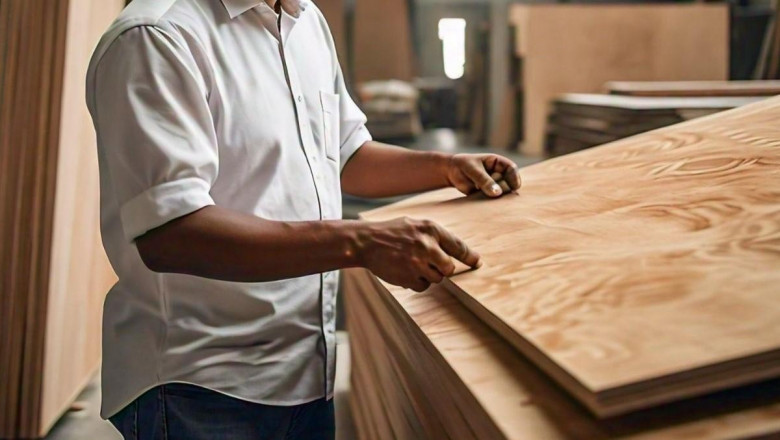views
IMARC Group’s “Plywood Manufacturing Plant Project Report 2025: Industry Trends, Plant Setup, Machinery, Raw Materials, Investment Opportunities, Cost and Revenue” report provides a comprehensive guide on how to successfully set up a plywood manufacturing plant. The report offers clarifications on various aspects, such as unit operations, raw material requirements, utility supply, infrastructural needs, machinery models, labour necessities, transportation timelines, packaging costs, etc.
In addition to the operational aspects, the report also provides in-depth insights into plywood manufacturing plant setup, project economics, encompassing vital aspects such as capital investments, project funding, operating expenses, income and expenditure projections, fixed and variable costs, direct and indirect expenses, expected ROI, net present value (NPV), profit and loss account, and thorough financial analysis, among other crucial metrics. With this comprehensive roadmap, entrepreneurs and stakeholders can make informed decisions and venture into a successful plywood manufacturing unit.
Request for a Sample Report: https://www.imarcgroup.com/plywood-manufacturing-plant-project-report/requestsample
What is Plywood?
Plywood is an engineered wood product made by bonding together thin layers, or "plies," of wood veneer with adhesive, with each layer's grain oriented perpendicular to the adjacent one. This cross-graining technique enhances the panel's strength, reduces the likelihood of splitting, and minimizes expansion and shrinkage due to moisture. The result is a versatile, durable, and dimensionally stable material used in a wide range of applications. Plywood is commonly utilized in construction for flooring, roofing, and wall sheathing, as well as in furniture making, cabinetry, and packaging. Various types of plywood are available to suit specific needs: softwood plywood is typically used in structural applications; hardwood plywood offers a fine finish for furniture; marine-grade plywood is designed for moisture resistance; and fire-retardant plywood is used in areas requiring enhanced fire safety. The combination of strength, flexibility, and affordability makes plywood a preferred choice in both residential and commercial projects.
Market Trend and Drivers of Plywood:
The plywood market is experiencing growth driven by several key factors. Rapid urbanization and infrastructure development, especially in emerging economies, have led to increased demand for construction materials, with plywood being a preferred choice due to its versatility and cost-effectiveness. The rise in residential and commercial construction projects necessitates materials suitable for flooring, roofing, and interior applications, further boosting plywood consumption. Additionally, the growing emphasis on sustainable and eco-friendly building practices has propelled the demand for plywood made from responsibly sourced timber and low-emission adhesives. Innovations in plywood manufacturing, such as the development of fire-resistant and moisture-resistant variants, have expanded its applications across various industries, including furniture, automotive, and packaging.
Key Aspects to Setup a Plywood Plant:
- Location to Setup Plant
- Market Research
- Plant Layout
- Construction and Infrastructure
- Equipment/Machinery Procurement
- Documentation and Licenses
- Cost Analysis
Requirements to Setup a Facility:
- Funds
- Machinery
- Lands
Types of Costs to Setup a Factory:
- Land, Location and Site Development Cost
- Plant Layout Cost
- Machinery Requirements and Costs
- Raw Material Requirements and Costs
- Packaging Requirements and Costs
- Transportation Requirements and Costs
- Utility Requirements and Costs
- Human Resource Requirements and Costs
Project Economics:
- Capital Investments
- Operating Costs
- Expenditure Projections
- Revenue Projections
- Taxation and Depreciation
- Profit Projections
- Financial Analysis
Key Questions Answered in the Report:
- How has the plywood market performed so far and how will it perform in the coming years?
- What is the market segmentation of the global plywood market?
- What is the regional breakup of the global plywood market?
- What are the price trends of various feedstocks in the plywood industry?
- What is the structure of the plywood industry and who are the key players?
- What are the various unit operations involved in a plywood manufacturing plant?
- What is the total size of land required for setting up a plywood manufacturing plant?
- What is the layout of a plywood manufacturing plant?
- What are the machinery requirements for setting up a plywood manufacturing plant?
- What are the raw material requirements for setting up a plywood manufacturing plant?
- What are the packaging requirements for setting up a plywood manufacturing plant?
- What are the transportation requirements for setting up a plywood manufacturing plant?
- What are the human resource requirements for setting up a plywood manufacturing plant?
- What are the infrastructure costs for setting up a plywood manufacturing plant?
- What are the capital costs for setting up a plywood manufacturing plant?
- And more…
How IMARC Can Help?
IMARC Group is a global management consulting firm that helps the world’s most ambitious changemakers to create a lasting impact. The company provide a comprehensive suite of market entry and expansion services. IMARC offerings include thorough market assessment, feasibility studies, company incorporation assistance, factory setup support, regulatory approvals and licensing navigation, branding, marketing and sales strategies, competitive landscape and benchmarking analyses, pricing and cost research, and procurement research.
Services:
- Plant Setup
- Factoring Auditing
- Regulatory Approvals, and Licensing
- Company Incorporation
- Incubation Services
- Recruitment Services
- Marketing and Sales
Contact Us:
IMARC Group
134 N 4th St. Brooklyn, NY 11249, USA
Email: sales@imarcgroup.com
Tel No:(D) +91 120 433 0800
United States: +1-631-791-1145














Comments
0 comment